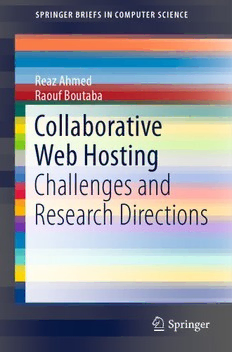Table Of ContentSPRINGER BRIEFS IN COMPUTER SCIENCE
Reaz Ahmed
Raouf Boutaba
Collaborative
Web Hosting
Challenges and
Research Directions
123
SpringerBriefs in Computer Science
SeriesEditors
StanZdonik
PengNing
ShashiShekhar
JonathanKatz
XindongWu
LakhmiC.Jain
DavidPadua
XueminShen
BorkoFurht
V.S.Subrahmanian
MartialHebert
KatsushiIkeuchi
BrunoSiciliano
Forfurthervolumes:
http://www.springer.com/series/10028
Reaz Ahmed • Raouf Boutaba
Collaborative Web Hosting
Challenges and Research Directions
123
ReazAhmed RaoufBoutaba
DavidR.CheritonSchool DavidR.CheritonSchool
ofComputerScience ofComputerScience
UniversityofWaterloo UniversityofWaterloo
Waterloo,ON,Canada Waterloo,ON,Canada
ISSN2191-5768 ISSN2191-5776(electronic)
ISBN978-3-319-03806-3 ISBN978-3-319-03807-0(eBook)
DOI10.1007/978-3-319-03807-0
SpringerChamHeidelbergNewYorkDordrechtLondon
LibraryofCongressControlNumber:2013955570
©TheAuthor(s)2014
Thisworkissubjecttocopyright.AllrightsarereservedbythePublisher,whetherthewholeorpartof
thematerialisconcerned,specificallytherightsoftranslation,reprinting,reuseofillustrations,recitation,
broadcasting,reproductiononmicrofilmsorinanyotherphysicalway,andtransmissionorinformation
storageandretrieval,electronicadaptation,computersoftware,orbysimilarordissimilarmethodology
nowknownorhereafterdeveloped.Exemptedfromthislegalreservationarebriefexcerptsinconnection
with reviews or scholarly analysis or material supplied specifically for the purpose of being entered
and executed on a computer system, for exclusive use by the purchaser of the work. Duplication of
this publication or parts thereof is permitted only under the provisions of the Copyright Law of the
Publisher’slocation,initscurrentversion,andpermissionforusemustalwaysbeobtainedfromSpringer.
PermissionsforusemaybeobtainedthroughRightsLinkattheCopyrightClearanceCenter.Violations
areliabletoprosecutionundertherespectiveCopyrightLaw.
Theuseofgeneraldescriptivenames,registerednames,trademarks,servicemarks,etc.inthispublication
doesnotimply,evenintheabsenceofaspecificstatement,thatsuchnamesareexemptfromtherelevant
protectivelawsandregulationsandthereforefreeforgeneraluse.
While the advice and information in this book are believed to be true and accurate at the date of
publication,neithertheauthorsnortheeditorsnorthepublishercanacceptanylegalresponsibilityfor
anyerrorsoromissionsthatmaybemade.Thepublishermakesnowarranty,expressorimplied,with
respecttothematerialcontainedherein.
Printedonacid-freepaper
SpringerispartofSpringerScience+BusinessMedia(www.springer.com)
Preface
TheWebhastremendousimportanceworldwide.Ithasarguablybecometheworld’s
greatest resource for information, and its success has fostered a variety of new
ways for people to share information, communicate, and interact. Over the past
decade, a wave of cultural phenomena – including Facebook, Google+, Flicker,
YouTube, and MySpace – have all utilized the Web as their interface. However,
cloud-basedsolutionsforonlinestorage,backup,andsharingofmultimediacontent
over the Web have inherent privacy perils. Users have to put their trust on the
cloud-serviceproviders.Serviceprovidersdictatethetermsofusage,andpotentially
gain control over users’ contents. Beside the privacy concern, transporting huge
volumes of user-generated, multimedia content to distant data centers may not
be bandwidth friendly for unpopular contents. A peer-to-peer (P2P) Web-based
content sharing architecture can subside these problems. This book investigates
the challenges in P2P web hosting and presents a potential solution named pWeb.
ThreemajorchallengeshavebeenaddressedinpWeb:(a)persistentnamingofWeb
contentsovernon-persistentP2Pnetworks,(b)decentralizedWebcontentsearching
and distributed ranking of search results, and (c) ensuring content availability
with minimal replication overhead. pWeb will allow free hosting of websites and
multimedia Web contents, without limitation on content type or size. This will
provide anybody the opportunity to publish to the masses, rather than restricting
thembyeconomics.Inaddition,freedomofspeechisavaluedprinciple;however
worldwide there are many who strive to block access to certain information. The
distributedapproachofpWebisinherentlyresistanttocensorship,andwillhelpto
spreadthisfreedomworldwide.
Waterloo,ON,Canada ReazAhmed
RaoufBoutaba
v
Contents
1 Introduction ................................................................... 1
1.1 ImportanceofP2PWebHosting ........................................ 2
1.2 Challenges................................................................ 3
1.2.1 Naming........................................................... 3
1.2.2 P2PWebSearch ................................................. 4
1.2.3 EnsuringContentAvailability................................... 4
1.3 Organization.............................................................. 5
References...................................................................... 5
2 Plexus:RoutingandIndexing ............................................... 7
2.1 CoreConceptsinPlexus................................................. 8
2.2 PlexusRouting........................................................... 9
2.3 UsingPlexusinpWeb.................................................... 10
References...................................................................... 11
3 Naming......................................................................... 13
3.1 Requirements............................................................. 13
3.2 WhoNeedsaName...................................................... 14
3.3 NaminginPeer-to-PeerSystems........................................ 15
3.3.1 FileSharingSystems ............................................ 15
3.3.2 BitTorrent ........................................................ 15
3.3.3 P2PDNS......................................................... 16
3.4 ACollaborativeNamingScheme ....................................... 17
3.4.1 EntitiesandRequirements....................................... 18
3.4.2 pWebNamingSystem........................................... 18
3.4.3 NamingScheme ................................................. 21
3.4.4 NamingAuthority ............................................... 22
3.4.5 NameResolution................................................. 24
3.4.6 MethodsforSelectingWebID.................................. 24
3.5 Summary ................................................................. 25
References...................................................................... 25
vii
viii Contents
4 CollaborativeWebSearch ................................................... 27
4.1 Requirements............................................................. 27
4.2 WebSearchinP2PNetworks ........................................... 28
4.2.1 SimilarKeywordSearch......................................... 28
4.2.2 DistributedRelevanceRanking ................................. 31
4.3 ACollaborativeApproach............................................... 32
4.3.1 NetworkArchitecture............................................ 32
4.3.2 IndexingArchitecture ........................................... 35
4.3.3 ResolvingWebQuery ........................................... 39
4.4 Summary ................................................................. 40
References...................................................................... 41
5 Availability..................................................................... 45
5.1 Requirements............................................................. 46
5.2 AvailabilityinP2PSystems ............................................. 47
5.3 ConceptualOverview.................................................... 48
5.3.1 Architecture...................................................... 48
5.3.2 AvailabilityVector............................................... 49
5.4 S-DATAProtocolDetails................................................ 50
5.4.1 Terminology...................................................... 50
5.4.2 IndexingAvailabilityInformation .............................. 51
5.4.3 GroupFormation................................................. 52
5.4.4 GroupMaintenance.............................................. 53
5.4.5 ContentIndexingandLookup................................... 54
5.5 Summary ................................................................. 54
References...................................................................... 55
6 Conclusion..................................................................... 57
Chapter 1
Introduction
Modeofinformationproduction,disseminationandconsumptionisgaininganew
momentum with the advent of cheaper and more powerful home entertainment
devices (like set-top-boxes, home-gateways, network-attached storages, gaming
consoles etc.) and hand-held devices (like smart-phones, tablets, portable gaming
devices etc.). Combining the powerful multimedia capabilities of the hand-held
deviceswiththepersistentuptimebehaviorofthehomeentertainmentdevices,users
canhaveanelevatedInternetexperienceinacost-effectivemanner.
Hand-held devices will increase dramatically in the upcoming years, which
is predictable from the prominent shift of the tech industry towards hand-held
devicemarket,speciallythesmartphonesandtabletPCs.Equippedwithpowerful
multimedia(e.g.,HDvideocamera,audio,GPSetc.)andnetworking(e.g.,Wi-fi,4G
LTE,Bluetoothetc.)capabilities,thesedevicesaregeneratingvoluminouscontent.
These devices are contributing significantly to the popular social networking sites
(e.g., Facebook) and online multimedia streaming portals (e.g., YouTube). As of
February2010,YouTubeservedonebillionvideosperday,andmoreinterestingly,
it would take 35h to watch the videos uploaded to YouTube per minute. Online
storageandbackupsolutionsareyetanotherclassofInternetapplicationsthatare
consistently gaining popularity. These solutions offer reliable online storage and
easeofaccessovertheInternet.
Cloud-based solutions for online storage, backup and sharing of multimedia
content over the Web have a few inherent drawbacks as pointed out in [3]. First,
voluminous multimedia content has to be uploaded to the cloud-stores, which
generates significant amount of Internet traffic. Second, building new data-centers
willgeneratemorepressureontheenergysector;asofFebruary,2009,Microsoft’s
datacenterinQuincy,Washingtonwasconsuming48MWofelectricity–sufficient
topoweraround40,000homes[1].
Transportinghugevolumesofusergenerated,multimediacontenttodistantdata-
centersisnotascalablesolution.Rather,semi-persistentdeviceslike,set-topboxes,
home-gateways, network-attached storages (NAS) etc., with network and storage
capabilities and residing near multimedia content production and consumption
R.AhmedandR.Boutaba,CollaborativeWebHosting,SpringerBriefsinComputer 1
Science,DOI10.1007/978-3-319-03807-0__1,©TheAuthor(s)2014

